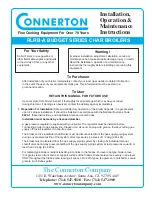
50
J.
TEST CONTROLS
WARNING
Before installation of the boiler is
considered complete, the operation of the
boiler controls should be checked,
particularly the low water cutoff and the
high limit control.
All controls must be checked prior to putting the boiler
in service.
1. CHECK OPERATING CONTROL OPERATION.
Raise and lower operating control setting as required
to start and stop burner.
2. CHECK OPERATION OF HIGH LIMIT
CONTROL —
Jumper Operating Control Terminals. Allow burner
to operate until shutdown by limit. Installation is
not considered complete until this check has been
made. REMOVE JUMPER.
3. CHECK LOW WATER CUTOFF control with water
level at normal water line (see Figure 1). Raise
operating control setting to allow burner to operate.
Open boiler drain to allow water level to drop to
bottom of sight glass until burner operation is shut
down by low water cutoff.
Close boiler drain and refill to normal water line.
Burner should automatically restart during fill.
RESET OPERATING CONTROL.
both the boiler circulator and the diverting valve
during periods of dormant activity provided power
is supplied to the control.
F.
DIVERTING VALVE ACTUATOR
- A 3-way
diverting valve is used to control the temperature of
the water returning to the boiler. Proper operation
is required to protect the boiler from thermal shock
and sustained condensate production. Confirm the
operation of the valve as shown above. See Figures 39a
and 39b.
G.
BOILER OPERATING AQUASTAT
– The operating
aquastat, L4006A, can be found on the front of the
boiler, to the right of the temperature/pressure gauge.
The operating aquastat should be set to the designed
supply temperature, typically 180ºF. The operating
aquastat set point, the RTC MIX TARGET or the RTC
MIX DESGN, should be set to the same value for
20°F
∆
T applications. In 40°F
∆
T applications, the
operating aquastat (L4006A) must be set 20°F higher
than the MIX TARGET and MIX DESIGN . Under
no circumstances should the operating aquastat be set
below 135ºF plus (+) the designed boiler temperature
drop,
∆
T (ºF).
Example: if the flow rate through the boiler
corresponds to a 20ºF
∆
T design, the operating
aquastat cannot be set lower than 135 + 20 = 155ºF.
In reality, most systems are designed for a 180ºF supply
water and 160ºF return water. The accuracy of the
operating aquastat is less than the RTC accuracy, often
requiring the operating aquastat temperature to be
bumped upward a few degrees.
H.
BOILER HIGH LIMIT AQUASTAT
– If used, the
high limit aquastat, L4006E, can be found on the front
of the boiler, to the left of the temperature/pressure
gauge. The high limit aquastat can be identified with a
red manual reset button. Ideally, the high limit aquastat
should be set 10 -15°F above the RTC MIX MAX
setting, when the outdoor reset feature is selected.
Typically, this is set between 200ºF and 220ºF. The
temperature must be set below the lowest permissible
temperature for any system related component affected
by boiler supply water. Under no circumstances can the
high limit aquastat be set higher than 250ºF.
I.
BOILER MODULATING CONTRO
L – Various
controls are used to modulate burner firing rates.
No attempt will be made to cover every possibility,
however a general outline will be given.
Most modulation controls require the entry of a
boiler temperature identifying boiler operation at the
maximum firing rate. A boiler operating temperature
below that will also generate a full firing rate. When a
boiler heat demand is generated the unit will initiate at
either a low or high fire rate and quickly ramp up to the
high fire rate. The unit will continue to fire at the high
fire rate until the boiler high fire modulating limit is
reached.
Many modulation controls require the entry of a burner
off or low fire setting. The burner will modulate
between the high fire and low fire rate based on the
absolute boiler temperature as well as the rate of change
in boiler temperature.
If using a T991 Proportional Control or a similar
modulating device in a traditional hydronic system,
the minimum setting shall be the sum of the designed
heating system return tempe boiler
∆
T + 10°F.
Example: System Supply 180°F
System Return 160°F
System
∆
T
20°F
Boiler
∆
T
40°F
Min. Setting = 160°F + 40°F + 10°F
= 210°F
*NOTE: A higher flow through the boiler, achieving
a 20°F
∆
T
would lower the minimum to 190°F.
If using the same control in a system where the
designed return is less than 135°F, then the minimum
becomes:
135°F + Boiler
∆
T + 10°F
Содержание 24-03
Страница 2: ...2...
Страница 8: ...8 Section I General Information FIGURE 1 Dimensional Information...
Страница 20: ...20 Figure 16 Bare Boiler Assembly...
Страница 24: ...24 Figure 22 Series 24 Jacket Assembly Boiler Models 24 03 thru 24 12...
Страница 29: ...29 This Page Is Intentionally Left Blank...
Страница 40: ...40 Figure 35 Typical Steam Piping Arrangement for Boilers with Pumped Condensate Return and Boiler Feed Unit...
Страница 45: ...45 Figure 41 Typical Boiler Wiring with RTC Front...
Страница 46: ...46 Figure 42 Typical Boiler with RTC Return Sensor Rear...
Страница 60: ...60 Figure 43 Series 24 Jacket Assembly Boiler Models 24 03 thru 24 12 SECTION VII REPAIR PARTS Continued...
Страница 62: ...62 Figure 44 Bare Boiler Assembly...
Страница 89: ...89 SERVICE RECORD DATE SERVICE PERFORMED...
















































